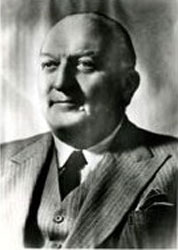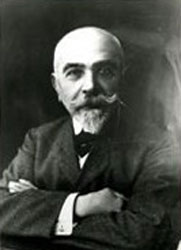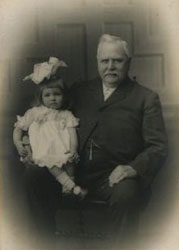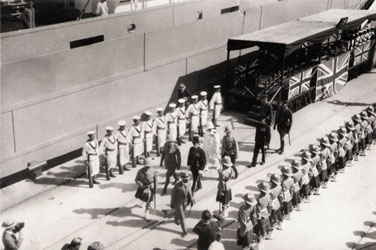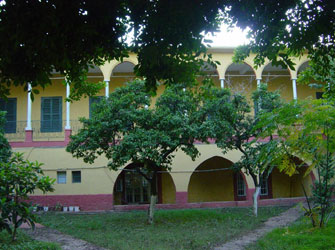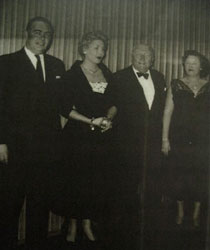This family hails from three different origins. This unification is important because they created the unique Beard Family. However, the Beard Family members see themselves as the successors of Beard, Catoni and Belfante families of the Levant. They continue to use the name of Catoni for their company and moreover, they use the name of Belfante and Catoni for their work in England as a symbol of their long standing successful strategy.
Among the three families, there were some similar events in their background. All of them chose to come to the Ottoman Empire in the 19th century. Gaining more money, living a higher standard of life, or serving for the Ottoman Empire were their main reasons for coming to the East. Dealing with these families in an alphabetical order:
The root of the Beard family were based in Scotland, in the western Isle of Skye. They were from the MacLeod clan who were a well-educated and sophisticated family. Their base was in Dunvegan Castle that is preserved as a museum today. This clan supported Prince ‘Bonnie’ Charles Edward Stuart against the king of Britain. However, they were not be successful against the king and the clan was scattered. Some of them moved to England and by changing names they hoped to integrate better at a time of social tensions. Their surname became Beard instead of Baird. Beards were a poor family who worked in the shoe trade and agriculture. Yet, Hugh Beard who was the father of Stanley Beard became a captain and he had his own ship. Therefore, he gained enough money to send his son to good schools. This was clearly very important for him. Stanley received his education in Switzerland and learnt German that allowed him to work in the Middle East. Stanley Beard is the grandfather of Jonathan and Christopher Beard, bringing the family story till today. As the Beard family’s life standards improved Stanley Beard decided to come to East in 1870. He was involved in the Baghdad Railway [archive views], a German – Turkish Project, as the chief engineer, which was run by Deutsche Bank. This represents the permanent move of the Beard family to the Levant. Later Stanley left this work and settled in Iskenderun [Alexandretta - archive views]in 1906. He commenced by trading in liquorice and he noticed that this plant from which the paste is extracted was widespread in Turkey and Syria. He began to buy in liquorice and constructed a liquorice processing factory in Iskenderun. He started to export this widely used product and when he grew rich, opened a new factory in Izmir that began the Beard Family’s relationship with that city. They worked with the Forbes family who were an equally well-known Levantine family, sharing their Scottish heritage and their descendants now possibly live in America.
The fortunes of the Beard family improve with time but the outbreak of the First World War creates a crisis, though the Ottoman Government treats the Levantines fairly and protects life and property. As Britain is on the Allied side to which Turkey founds itself in opposition, Stanley Beard is brought to the bastion of Kadifekale [Mount Pagus] as a prisoner, though with relaxed conditions. With the end of the war, Stanley Beard returns to Iskenderun, but the liquorice concern is now named Forbes.
Following World War II, Augustine Catoni and Stanley Beard started to work as partners, and amongst their major capital projects are the first petroleum refinery in Lebanon and the first oil pipeline in Iraq. In addition the Iraq – Iskenderun crude oil pipeline construction project is another Catoni company achievement. Before this business and family union, the Catoni family were united with the Belfante family. Augustine Joseph Catoni, whose family were in Turkey since 1846 marries a daughter of the Belfante family who had moved to Iskenderun back in 1820. The Catoni family acquire all the interests and property of the Belfante family with this union and later when the Catoni family name dies out, the Beard family become sole owners.
The Belfante family had to leave their native Corsica as they were royalists during the French revolution, joining the Egyptian Army of Mehmet Ali Pasha, the nominal Ottoman governor of the province. In the Egyptian army Belfante is employed as an artillery officer based in Aleppo. Later leaving army service Belfante settles in Iskenderun [view archive letter], where on 1st February 1880 together with the local British Consul Augustine Catoni, he forms the partnership firm of Belfante & Catoni. This firm grows in strength and later with the move of Belfante back to France, Catoni becomes the sole owner of the firm. Belfante also leaves to his partner the shipping firm Messageries Maritime.
The Catoni family have an Italian origin and in the period of the minor Italian states squabbling amongst each other, being on the losing side of one, had to escape to Cyprus. Augustine Catoni was born on this island in 1823, and later became a shipping agent and later moved his business to Iskenderun. His business interests were wide including import export of timber and farming. Most of the local population of this port city were employed in some ways by the Catoni firm which almost became their town. Other successes of the Catoni concern were the appointment as the Lloyd’s agent for this city in 1885, the partnership with the Asiatic Steamship Co. Also establishing the Prince Line, the foundation of the British Maritime Agency’s Levant Ltd., and becoming the shipping agents of Ellerman in Beirut, Moss and Hutchinson Lines. The family carried on the successes with the obtaining the agency right for Lloyd’s in Mersin in 1947 and Beirut in 1963 and also the creation in 1953 at Lattakia of the Syrian Maritime and Transport Agencies SAS.
Of these three inter-related families, the first to arrive in Turkey was Catoni (1820s Cyrus, 1846 Iskenderun) and the last was Beard (1870s).
With the marriage of Norah Beard to Augustine Catoni in 1947, her brother Hugh Beard starts working for the Catoni firm. When Catoni states he doesn’t want to live in Lebanon anymore, they agree that the offices in Turkey to be in the control of Hugh Beard and the offices in Jordan, Iraq and Syria to be in the control of Catoni. With this Hugh Beard moves the office in Iskenderun to Istanbul in the 1950s, from whence the company continues to perform till today.
Brief biography: Eda Kaçar Özmutaf is a graduate of Istanbul Yeditepe University where during her third year of education within the specialasation of Ottoman Diplomatic History, the subject ‘the Levant Company’ entered the group discussion, and this eventually led to her chosing the nature and identity of Levantines as the subject of her dissertation. Eda is currently continuing her studies under a Master programme at Ege University in Izmir on ‘Modern age history’, continuing on the same quest of seeking answers to the same topic started back in Istanbul.
Eda is currently (2011-12) studying for a Master degree thesis project on the British trade in Smyrna in the 19th century. She is planning to achieve this through analysis of trade documents and economic appraisal of Smyrna Levantines and has visited more than once the National Archives in London for this aim/project. Her chief sources are based on the British Consulate Reports of the time. She intends to widen this search by including diverse sources connected to Levantines of the 19th and early 20th century, again concentrating her research at the National Archives.
Eda has also taken private commissions to aid family history researchers based abroad, as they seek answers to their own Levantine roots, and is open for future offers and is contactable through edaozmutaf[at]gmail.com. Eda is also a contributor to the recently (2017) launched history and technology online journal (p. 54-55) dealing with the Ege University Art of Paper and Books Museum, and in addition an education resource article dealing with the 1845 fire of Smyrna, viewable here:
 submission date 2010
submission date 2010
Among the three families, there were some similar events in their background. All of them chose to come to the Ottoman Empire in the 19th century. Gaining more money, living a higher standard of life, or serving for the Ottoman Empire were their main reasons for coming to the East. Dealing with these families in an alphabetical order:
The root of the Beard family were based in Scotland, in the western Isle of Skye. They were from the MacLeod clan who were a well-educated and sophisticated family. Their base was in Dunvegan Castle that is preserved as a museum today. This clan supported Prince ‘Bonnie’ Charles Edward Stuart against the king of Britain. However, they were not be successful against the king and the clan was scattered. Some of them moved to England and by changing names they hoped to integrate better at a time of social tensions. Their surname became Beard instead of Baird. Beards were a poor family who worked in the shoe trade and agriculture. Yet, Hugh Beard who was the father of Stanley Beard became a captain and he had his own ship. Therefore, he gained enough money to send his son to good schools. This was clearly very important for him. Stanley received his education in Switzerland and learnt German that allowed him to work in the Middle East. Stanley Beard is the grandfather of Jonathan and Christopher Beard, bringing the family story till today. As the Beard family’s life standards improved Stanley Beard decided to come to East in 1870. He was involved in the Baghdad Railway [archive views], a German – Turkish Project, as the chief engineer, which was run by Deutsche Bank. This represents the permanent move of the Beard family to the Levant. Later Stanley left this work and settled in Iskenderun [Alexandretta - archive views]in 1906. He commenced by trading in liquorice and he noticed that this plant from which the paste is extracted was widespread in Turkey and Syria. He began to buy in liquorice and constructed a liquorice processing factory in Iskenderun. He started to export this widely used product and when he grew rich, opened a new factory in Izmir that began the Beard Family’s relationship with that city. They worked with the Forbes family who were an equally well-known Levantine family, sharing their Scottish heritage and their descendants now possibly live in America.
The fortunes of the Beard family improve with time but the outbreak of the First World War creates a crisis, though the Ottoman Government treats the Levantines fairly and protects life and property. As Britain is on the Allied side to which Turkey founds itself in opposition, Stanley Beard is brought to the bastion of Kadifekale [Mount Pagus] as a prisoner, though with relaxed conditions. With the end of the war, Stanley Beard returns to Iskenderun, but the liquorice concern is now named Forbes.
|
|
|
Following World War II, Augustine Catoni and Stanley Beard started to work as partners, and amongst their major capital projects are the first petroleum refinery in Lebanon and the first oil pipeline in Iraq. In addition the Iraq – Iskenderun crude oil pipeline construction project is another Catoni company achievement. Before this business and family union, the Catoni family were united with the Belfante family. Augustine Joseph Catoni, whose family were in Turkey since 1846 marries a daughter of the Belfante family who had moved to Iskenderun back in 1820. The Catoni family acquire all the interests and property of the Belfante family with this union and later when the Catoni family name dies out, the Beard family become sole owners.
The Belfante family had to leave their native Corsica as they were royalists during the French revolution, joining the Egyptian Army of Mehmet Ali Pasha, the nominal Ottoman governor of the province. In the Egyptian army Belfante is employed as an artillery officer based in Aleppo. Later leaving army service Belfante settles in Iskenderun [view archive letter], where on 1st February 1880 together with the local British Consul Augustine Catoni, he forms the partnership firm of Belfante & Catoni. This firm grows in strength and later with the move of Belfante back to France, Catoni becomes the sole owner of the firm. Belfante also leaves to his partner the shipping firm Messageries Maritime.
The Catoni family have an Italian origin and in the period of the minor Italian states squabbling amongst each other, being on the losing side of one, had to escape to Cyprus. Augustine Catoni was born on this island in 1823, and later became a shipping agent and later moved his business to Iskenderun. His business interests were wide including import export of timber and farming. Most of the local population of this port city were employed in some ways by the Catoni firm which almost became their town. Other successes of the Catoni concern were the appointment as the Lloyd’s agent for this city in 1885, the partnership with the Asiatic Steamship Co. Also establishing the Prince Line, the foundation of the British Maritime Agency’s Levant Ltd., and becoming the shipping agents of Ellerman in Beirut, Moss and Hutchinson Lines. The family carried on the successes with the obtaining the agency right for Lloyd’s in Mersin in 1947 and Beirut in 1963 and also the creation in 1953 at Lattakia of the Syrian Maritime and Transport Agencies SAS.
Of these three inter-related families, the first to arrive in Turkey was Catoni (1820s Cyrus, 1846 Iskenderun) and the last was Beard (1870s).
|
|
|
With the marriage of Norah Beard to Augustine Catoni in 1947, her brother Hugh Beard starts working for the Catoni firm. When Catoni states he doesn’t want to live in Lebanon anymore, they agree that the offices in Turkey to be in the control of Hugh Beard and the offices in Jordan, Iraq and Syria to be in the control of Catoni. With this Hugh Beard moves the office in Iskenderun to Istanbul in the 1950s, from whence the company continues to perform till today.
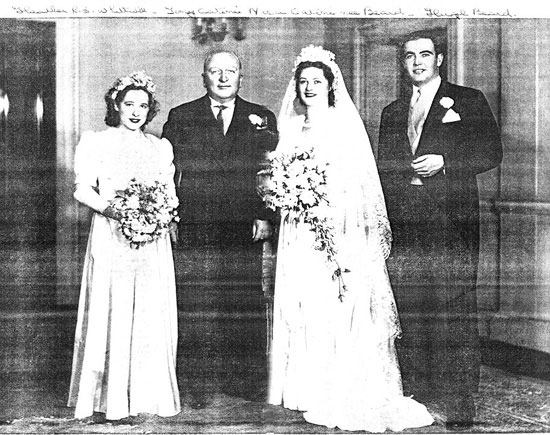 |
The wedding
of De Jongh descendant Norah Beard (b. Smyrna 1918) and Augustine “Tony”
(aka “Titino”) Catoni (b. Smyrna-? 1900), London 1947, flanked by DJ descendants
Heather Whittall m. Lovelock (b. Izmir 1930) and Hugh Beard (b. Smyrna 1922).
Hugh (middle names James Boag) Beard is
the father of the Hugh Jonathan Boag “Jonathan” Beard.
Brief biography: Eda Kaçar Özmutaf is a graduate of Istanbul Yeditepe University where during her third year of education within the specialasation of Ottoman Diplomatic History, the subject ‘the Levant Company’ entered the group discussion, and this eventually led to her chosing the nature and identity of Levantines as the subject of her dissertation. Eda is currently continuing her studies under a Master programme at Ege University in Izmir on ‘Modern age history’, continuing on the same quest of seeking answers to the same topic started back in Istanbul.
Eda is currently (2011-12) studying for a Master degree thesis project on the British trade in Smyrna in the 19th century. She is planning to achieve this through analysis of trade documents and economic appraisal of Smyrna Levantines and has visited more than once the National Archives in London for this aim/project. Her chief sources are based on the British Consulate Reports of the time. She intends to widen this search by including diverse sources connected to Levantines of the 19th and early 20th century, again concentrating her research at the National Archives.
Eda has also taken private commissions to aid family history researchers based abroad, as they seek answers to their own Levantine roots, and is open for future offers and is contactable through edaozmutaf[at]gmail.com. Eda is also a contributor to the recently (2017) launched history and technology online journal (p. 54-55) dealing with the Ege University Art of Paper and Books Museum, and in addition an education resource article dealing with the 1845 fire of Smyrna, viewable here:

